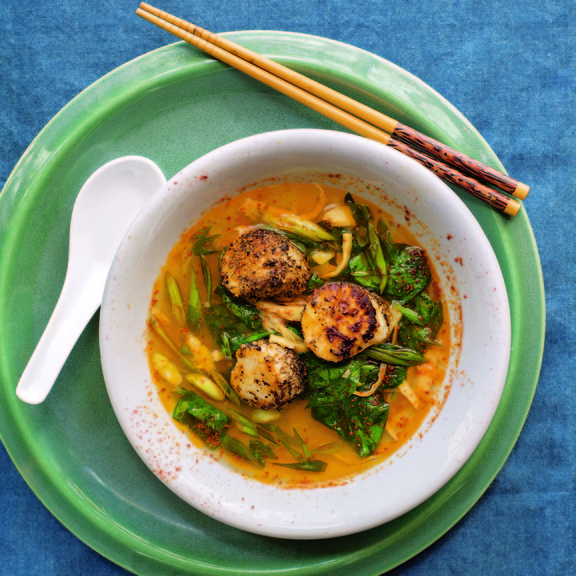SEARED SCALLOPS IN ASIAN BROTH
Kerry Altiero: “Scallops have to be one of the world’s great high-end proteins. OK, yes, I say this about tuna, lobster, crab … but it’s all true. Searing a scallop on a cast-iron pan makes a sweet (like sugar, not like a figure of speech from a ski bum) caramelized coating that is, well, pretty sweet. Serving these in a broth spiced with Thai flavors is downright elegant.”
Serves 1
3 ounces dry Maine sea scallops
Olive oil
½ cup fish fumet, fish stock or canned clam juice (choose a natural, low-salt clam juice)
2 tablespoons bamboo shoots marinated in chili oil (available at Asian markets)
4 leaves Thai basil
2 scallions, sliced on the bias
Lemon wedge
Heat your 9-inch cast-iron pan on high heat.
Oil the scallops just to coat and place on the skillet. Let the first side brown well.
The aroma is intoxicating! The scallops’ interiors should stay cool to the touch. Do not flip them. Just get that brown caramelization thing happening and remove from the heat. It should take 4 minutes or so.
In a 3-quart nonreactive saucepan, warm the fumet to just short of boiling.
Then remove the saucepan full of fumet from the heat and add the bamboo shoots and basil. Turn out this mixture into an Asian-style bowl (like the ones used for pho or donburi). Place the scallops seared side up on top of the mixture. Sprinkle with the scallions. Squeeze the lemon over and toss the wedge into the bowl.
Serve with a flat-bottomed Asian soup spoon and a pair of chopsticks.
CHEF’S TIP: Look for “dry” scallops. The best are “diver” scallops, fetched from King Neptune’s locker by a person in scuba gear. These are great just as they come. Squeeze a lime, salt one and eat it raw. Second choice is “day boat.” Just as it sounds: The fishermen come in every night to land the catch, so you can buy it fresh. After that comes “dragger” scallops, which are perfectly acceptable as long as they are “dry.” This has nothing to do with their wit or humor, more with processing. It means they haven’t been soaked in water, brine or chemicals that plump them up and add to their weight. The liquid makes it difficult, if not impossible, to sear them. So check with your fishmonger, and call them on it if your “dry” scallops start bleeding water. And yes, those “individually quick frozen” ones fall into the “wet” category.
Send questions/comments to the editors.



Success. Please wait for the page to reload. If the page does not reload within 5 seconds, please refresh the page.
Enter your email and password to access comments.
Hi, to comment on stories you must . This profile is in addition to your subscription and website login.
Already have a commenting profile? .
Invalid username/password.
Please check your email to confirm and complete your registration.
Only subscribers are eligible to post comments. Please subscribe or login first for digital access. Here’s why.
Use the form below to reset your password. When you've submitted your account email, we will send an email with a reset code.